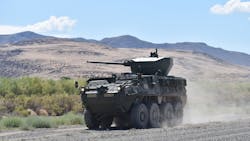Army picks Oshkosh Defense to build 30-millimeter cannon and vetronics for Stryker armored combat vehicles
WARREN, Mich. – U.S. Army armored combat vehicles experts are choosing Oshkosh Defense LLC in Oshkosh, Wis., to build the weapon system for the General Dynamics Stryker wheeled fighting vehicle equipped with an armor-piercing or high-explosive 30-millimeter cannon.
Officials of the Army Contracting Command at Detroit Arsenal in Warren, Mich., announced a $942.9 million contract to Oshkosh earlier this month to build and support the Stryker Medium-Caliber Weapon System.
This version of the eight-wheel Stryker combat vehicle will have the 30-millimeter cannon for attacking lightly armored vehicles and bunkers.
The Addition of a 30-millimeter cannon turret to the Stryker can boost the vehicle's firepower substantially. A 30-millimeter cannon bullet is about 10 inches long, while a .50 caliber machine gun bullet is about five inches long, and a 7.62 millimeter machine gun bullet is about three inches long.
The 30-millimeter cannon fires a shell slightly more than one inch in diameter that comes in armor-piercing, high-explosive, or practice rounds. The weapon has a barrel diameter of 1.18 inches.
This newest version of the Stryker joins other variants for missions that include armored personnel carrier; battlefield reconnaissance; light main battle tank with a 105-millimeter cannon; mortar carrier; commander's vehicle; fire support; medical evacuation; and anti-tank missile launcher.
Stryker is a deployable fighting vehicle that is more lethal than light vehicles like Humvees, yet is lighter and more maneuverable than heavyweight combat vehicles like the M1 Abrams main battle tank.
Most Stryker vehicles and vetronics today can have the Protector M151 Remote Weapon Station with .50-cal M2 machine gun, 7.62 mm M240 machine gun, or Mk-19 automatic grenade launcher. Some heavily armed versions have a 105-millimeter main gun, similar to a tank.
Related: General Dynamics to equip Stryker combat vehicle with 30-millimeter cannon unmanned turret
The Stryker also establishes the framework for the Vehicular Integration for C4ISR/EW Interoperability (VICTORY) vetronics architecture for networking integration and data sharing among the vehicle's common crew stations. The new Stryker version also provides Gigabit Ethernet capability.
The modern version of Stryker has a 910-amp alternator to support future electrical power upgrades for future network equipment; an enhanced power distribution unit chassis upgrade; increased chassis payload capacity from 55,000 pounds to 63,000 pounds; and upgrades to its driveline to support an in-vehicle network architecture.
The Stryker armored combat vehicle is named for two American servicemen who posthumously received the Medal of Honor: Private First Class Stuart S. Stryker, who died in World War II, and Specialist Four Robert F. Stryker, who died in the Vietnam War.
On this contract Oshkosh will do the work at locations be determined with each order, and should be finished by June 2027. For more information contact Oshkosh Defense online at https://oshkoshdefense.com,or U.S. Army Contracting Command-Detroit Arsenal at https://home.army.mil/detroit.

John Keller | Editor-in-Chief
John Keller is the Editor-in-Chief, Military & Aerospace Electronics Magazine--provides extensive coverage and analysis of enabling electronics and optoelectronic technologies in military, space and commercial aviation applications. John has been a member of the Military & Aerospace Electronics staff since 1989 and chief editor since 1995.

